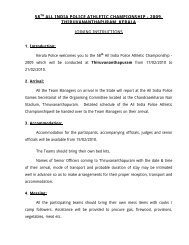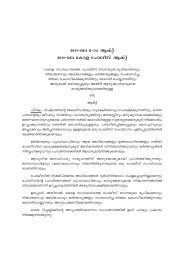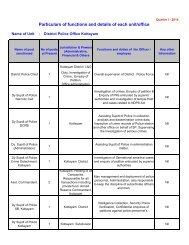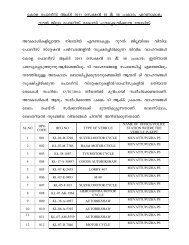Janamaithri Suraksha Project - Kerala Police
Janamaithri Suraksha Project - Kerala Police
Janamaithri Suraksha Project - Kerala Police
Create successful ePaper yourself
Turn your PDF publications into a flip-book with our unique Google optimized e-Paper software.
to note that the <strong>Kerala</strong> <strong>Police</strong> leadership now observe that the JSPs are working well not merely<br />
because of the Samithi membership that mobilises public participation in the initiative. It was found<br />
that grass roots involvement resulted in non-Samithi members coming to meetings so to provide<br />
their feedback and inputs.19 While the composition of the Samithi remains important, that by itself<br />
does not guarantee success. It is important that the layman is also involved and that can only<br />
occur with greater awareness of the objectives and purposes of the JSP.<br />
However there is one area of concern. The Samithis’ constitution and selection of members<br />
is left ,entirely to the District <strong>Police</strong> Chief. There are concerns that members of the $amithis do not<br />
necessarily reflect the diversity of a’ particular community and are at times ‘friends or favourites of<br />
the police’. Whilst this criticism may be unfounded, leaving the selection solely to the discretion of<br />
the District <strong>Police</strong> Chief will only escalate these concerns. For community policing to be truly<br />
effective, it should be inclusive and allow for maximum participation.<br />
A crucial element leading to the success of any community policing initiative is the training of<br />
police/Beat Officers. The <strong>Kerala</strong> police laid great emphasis on this. Since the ‘entire success of<br />
the JSP hinges on the effectiveness of the Beat Officers, it is critically important that their capacity<br />
is built so that they can solve problems. and deal with the public in a thoughtful and respectful<br />
manner. JSP training is conducted at the State Level (in either Thrissur or Thiruvananthapuram)<br />
by senior police officials where 40-50 people are trained over three days. When the JSP was<br />
implemented in the first 20 police stations of Phase I, the DGP, Jacob Punnoose, Dr.B.Sahdhya<br />
(IGP and Nodal Officer for the JSP) and Mr.Hemachandran(IGP Range) personally interacted with<br />
each Beat Officer during the training phase.<br />
Furthermore , during the training for Phase I, which was also done at the district level, community<br />
members were included. The training was largely about teaching Beat Officers on how to listen to<br />
people rather than simply expecting the public to obey them. In that way, their mindset had to be<br />
changed and this could be done only under the dose supervision of senior police leadership. Political<br />
acceptance of this initiative was crucial for its success. The <strong>Kerala</strong> police managed this by getting both<br />
the ruling and ‘opposition, parties agreeing to the idea of community policing. As-with any aspect of<br />
police reform, nothing substantive can be accomplished in the absence of political will. The important<br />
consultations in September 2007 laid the groundwork for a non- politicised approach to the JSP. If the<br />
JSP had been viewed as a political project, very little would have been accomplished,” One sign of the<br />
JSP’s success is that politicians from various political parties expressed an interest in undertaking<br />
community policing in their jurisdictions. With ,140 Assembly seats in the state and only 43 JSPs<br />
underway, several MLAs are clamouring for Phase III JSPs to be initiated in their constituencies.<br />
Finally, the-fact remains that the JSP would not work if it were inadequately resourced. In<br />
2009, the JSP received Rs.42 lakh and in 2010, Rs. 254 lakh.83 While more money is always<br />
required for ambitious undertakings such as the JSP, the <strong>Kerala</strong> government’s commitment to the<br />
initiative is evidenced by the substantial amount of funds they have allocated to date.<br />
3. Organisation<br />
The success of a community policing initiative is often contingent on the strength of that jurisdiction’s<br />
police leadership. In <strong>Kerala</strong>, the JSP benefited tremendously with DG Punnoose and IGP Sandhya<br />
spearheading the effort. Both demonstrated a willingness to listen to the public, including nongovernmental<br />
organisations and to adapt to constantly changing circumstances. Importantly, the<br />
<strong>Kerala</strong> government chose not to; transfer DG Punnoose prematurely and permitted him to stay on<br />
as Director General so that he may competently guide the JSP through its critical first steps, After<br />
the elections and the change in government ‘in early’201l, there were no major transfers of crucial<br />
police posts. Even with a change in political leadership, the police leadership was permitted to<br />
continue functioning without major disruptions.<br />
Additionally the <strong>Kerala</strong> police has instituted strict criterion for the recruitment of Beat Officers. The<br />
criterion takes into account traits such as past performance, bad habits (i.e. drinking), and<br />
demonstrated good behaviour towards the public. Before selecting a Beat Officer, these<br />
35

















